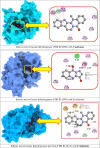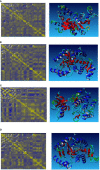Anti-parasitic drug discovery against Babesia microti by natural compounds: an extensive computational drug design approach
- PMID: 37662005
- PMCID: PMC10469490
- DOI: 10.3389/fcimb.2023.1222913
Anti-parasitic drug discovery against Babesia microti by natural compounds: an extensive computational drug design approach
Abstract
Tick-borne Babesiosis is a parasitic infection caused by Babesia microti that can infect both animals and humans and may spread by tick, blood transfusions, and organ transplantation. The current therapeutic options for B. microti are limited, and drug resistance is a concern. This study proposes using computational drug design approaches to find and design an effective drug against B. microti. The study investigated the potentiality of nine natural compounds against the pathogenic human B. microti parasite and identified Vasicinone and Evodiamine as the most promising drugs. The ligand structures were optimized using density functional theory, molecular docking, molecular dynamics simulations, quantum mechanics such as HOMO-LUMO, drug-likeness and theoretical absorption, distribution, metabolism, excretion, and toxicity (ADMET), and pharmacokinetics characteristics performed. The results showed that Vasicinone (-8.6 kcal/mol and -7.8 kcal/mol) and Evodiamine (-8.7 kcal/mol and -8.5 kcal/mol) had the highest binding energy and anti-parasitic activity against B. microti lactate dehydrogenase and B. microti lactate dehydrogenase apo form. The strongest binding energy was reported by Vasicinone and Evodiamine; the compounds were evaluated through molecular dynamics simulation at 100 ns, and their stability when they form complexes with the targeted receptors was determined. Finally, the pkCSM web server is employed to predict the ADMET qualities of specific molecules, which can help prevent negative effects that arise from taking the treatment. The SwissADME web server is used to assess the Lipinski rule of five and drug-likeness properties including topological polar surface area and bioavailability. The Lipinski rule is used to estimate significant drug-likeness. The theoretical pharmacokinetics analysis and drug-likeness of the selected compounds are confirmed to be accepted by the Lipinski rule and have better ADMET features. Thus, to confirm their experimental value, these mentioned molecules should be suggested to carry out in wet lab, pre-clinical, and clinical levels.
Keywords: ADMET; B. microti; DFT; and drug design; molecular docking; molecular dynamic simulation.
Copyright © 2023 Akash, Hosen, Mahmood, Supti, Kumer, Sultana, Jannat, Bayıl, Nafidi, Jardan, Mekonnen and Bourhia.
Conflict of interest statement
The authors declare that the research was conducted in the absence of any commercial or financial relationships that could be construed as a potential conflict of interest.
Figures







Similar articles
-
Novel computational and drug design strategies for inhibition of monkeypox virus and Babesia microti: molecular docking, molecular dynamic simulation and drug design approach by natural compounds.Front Microbiol. 2023 Jul 19;14:1206816. doi: 10.3389/fmicb.2023.1206816. eCollection 2023. Front Microbiol. 2023. PMID: 37538847 Free PMC article.
-
Design and screening of novel molecular compounds targeting lactate dehydrogenase of Babesia microti.Parasit Vectors. 2025 Feb 23;18(1):69. doi: 10.1186/s13071-024-06623-9. Parasit Vectors. 2025. PMID: 39988659 Free PMC article.
-
Investigation of the New Inhibitors by Sulfadiazine and Modified Derivatives of α-D-glucopyranoside for White Spot Syndrome Virus Disease of Shrimp by In Silico: Quantum Calculations, Molecular Docking, ADMET and Molecular Dynamics Study.Molecules. 2022 Jun 8;27(12):3694. doi: 10.3390/molecules27123694. Molecules. 2022. PMID: 35744817 Free PMC article.
-
Comparative Bioinformatics Analysis of Transcription Factor Genes Indicates Conservation of Key Regulatory Domains among Babesia bovis, Babesia microti, and Theileria equi.PLoS Negl Trop Dis. 2016 Nov 10;10(11):e0004983. doi: 10.1371/journal.pntd.0004983. eCollection 2016 Nov. PLoS Negl Trop Dis. 2016. PMID: 27832060 Free PMC article. Review.
-
Vaccination against babesiosis using recombinant GPI-anchored proteins.Int J Parasitol. 2019 Feb;49(2):175-181. doi: 10.1016/j.ijpara.2018.12.002. Epub 2019 Jan 24. Int J Parasitol. 2019. PMID: 30684517 Review.
Cited by
-
Modulating the antibacterial effect of the existing antibiotics along with repurposing drug metformin.Arch Microbiol. 2024 Mar 23;206(4):190. doi: 10.1007/s00203-024-03917-5. Arch Microbiol. 2024. PMID: 38519821
-
Multitargeted docking approach reveals droxidopa against DNA replication and repair-related protein of cervical cancer.Sci Rep. 2024 Oct 16;14(1):24301. doi: 10.1038/s41598-024-72770-9. Sci Rep. 2024. PMID: 39414839 Free PMC article.
-
Phyto-pharmacological and computational profiling of Bombax ceiba Linn. Leaves revealed pharmacological properties against oxidation, hyperglycemia, pain, and diarrhea.Heliyon. 2024 Jul 30;10(15):e35422. doi: 10.1016/j.heliyon.2024.e35422. eCollection 2024 Aug 15. Heliyon. 2024. PMID: 39170236 Free PMC article.
-
Anxiolytic Efficacy of Indirubin: In Vivo Approach Along with Receptor Binding Profiling and Molecular Interaction with GABAergic Pathways.ChemistryOpen. 2025 Feb;14(2):e202400290. doi: 10.1002/open.202400290. Epub 2024 Oct 25. ChemistryOpen. 2025. PMID: 39460441 Free PMC article.
-
Exploring the Therapeutic Potential of Petiveria alliacea L. Phytochemicals: A Computational Study on Inhibiting SARS-CoV-2's Main Protease (Mpro).Molecules. 2024 May 27;29(11):2524. doi: 10.3390/molecules29112524. Molecules. 2024. PMID: 38893400 Free PMC article.
References
-
- Abraham A., Thekkiniath J., Kilian N., Lawres L., Gao R., Debus K., et al. . (2018). Establishment of a continuous In vitro culture of babesia duncani in human erythrocytes reveals unusually high tolerance to recommended therapies. J. Of. Biol. Chem. 293, 19974–19981. doi: 10.1074/jbc.AC118.005771 - DOI - PMC - PubMed
-
- Aguero-Rosenfeld M. (2011). “Committee on Lyme disease and other tick-borne diseases: the state of the science, institute of medicine,” in Critical needs and gaps in understanding prevention, amelioration, and resolution of Lyme and other tick-borne diseases [Electronic resource]: the short-term and long-term outcomes: workshop report [Internet] (Washington, DC: National Academies Press; ). - PubMed
-
- Babes V. (1888). Sur l’hemoglobinurie bacterienne Du boeuf. Cr. Acad. Sci. 107, 692–694.
-
- Baildya N., Khan A. A., Ghosh N. N., Dutta T., Chattopadhyay A. P. (2021). Screening of potential drug from azadirachta indica (Neem) extracts for SARS-Cov-2: an insight from molecular docking and MD-simulation studies. J. Of. Mol. Structure. 1227, 129390. doi: 10.1016/j.molstruc.2020.129390 - DOI - PMC - PubMed
-
- Bastos R. G., Thekkiniath J., Ben Mamoun C., Fuller L., Molestina R. E., Florin-Christensen M., et al. . (2021). Babesia microti immunoreactive rhoptry-associated protein-1 paralogs are ancestral members of the piroplasmid-confined rap-1 family. Pathogens 10, 1384. doi: 10.3390/pathogens10111384 - DOI - PMC - PubMed
Publication types
MeSH terms
Substances
LinkOut - more resources
Full Text Sources
Miscellaneous

